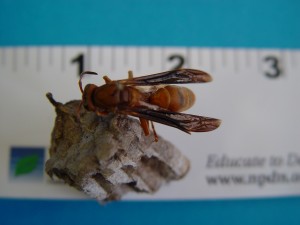Most humans fear and hate yellow jackets. They are actually wasps and important predators of several harmful insects. They’re easily identified by their distinctive markings along their abdomen. They tend to dart about rapidly, in a side-to-side flight pattern. Female yellow jackets are the ones capable of stinging.
Wasps (Vespula spp.) are not bees; they’re brightly colored “cousins” of ground bees. In late summer, while most ground nesting bees are storing up food for the winter, wasps begin to emerge. They had constructed their nests in cool spots such as old rodent burrows, ground holes, under roof eaves, and in mortar cracks between bricks of buildings.
Yellow jackets are social insects. They are not pollinators, but do prey on other pollinating insects and nectar. They scavenge on animal wastes and foods high in protein or sugar. Wasps are highly aggressive and are easily provoked by humans. Favorite places to forage include waste receptacles, soda cans, and picnic foods which they carry back to their nest.
The aggressive behavior of yellow jackets, coupled with their tendency to attack as a group, makes them formidable pests to deal with. When outdoors follow these few wasp avoiding tips. Keep all liquids covered. Don’t swat or crush yellow jackets as this may incite other yellow jackets to attack. If you get too near a nest, backoff slowly. Do not wear bright colored clothes or heavy perfumes.
Call a professional exterminator who has the knowledge, safety clothing, and proper pesticides to find and destroy nests close by your home or patio. Otherwise, leave these mostly beneficial insects alone.


 Posted in
Posted in 
